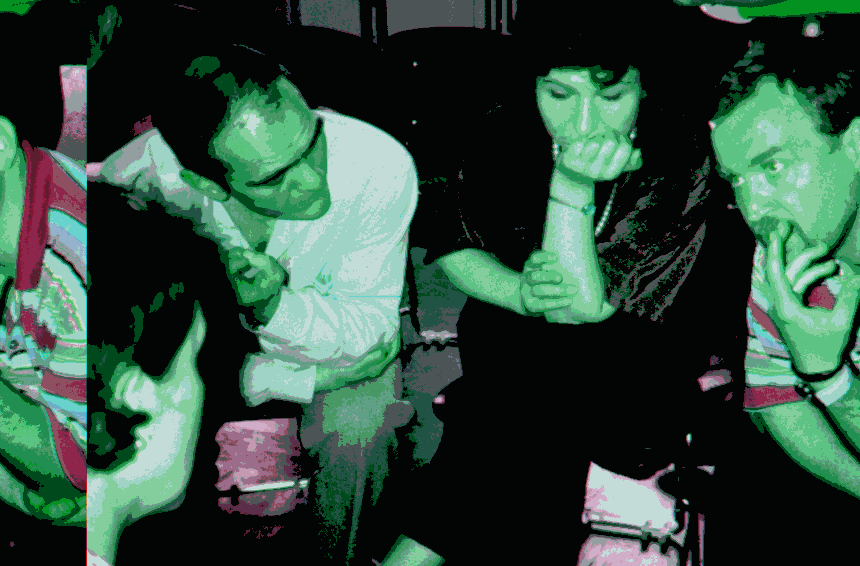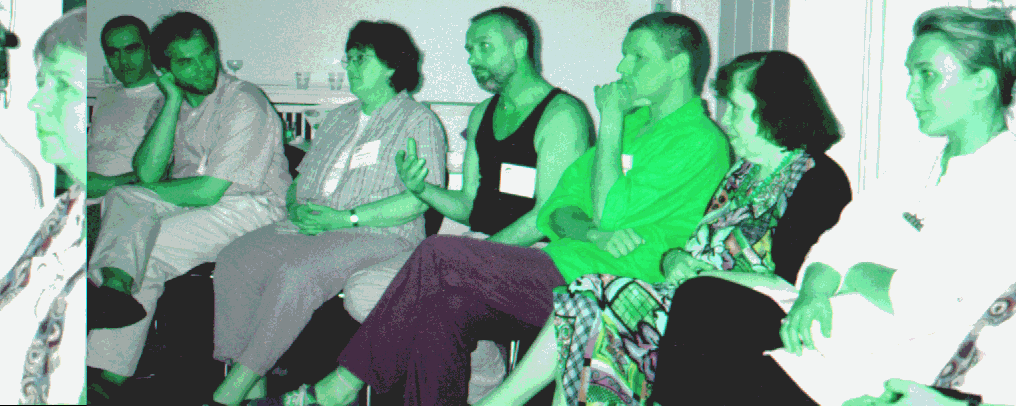|
|
|
OVERCOMING VIOLENCE: PERSONS, FAMILIES AND SOCIETIES Report on the 7th International Working Meeting of SiT,
May 13-15, 1998, in Düsseldorf, GermanyThis year's Annual Meeting of the Systems in Transition International Network of mental health professionals was designed as an introduction to our three-year focus on the topic of Violence. 40 Psychologists, psychiatrists, family therapists, psychoanalysts and social researchers from 19 countries met to discover which dimensions of violence are most relevant to our members and to develop a joint framework for further research. Since the specific characteristic of our work is a productive co-existence of theoretical and experiential dimensions as well as of people from many different societies, we began by approaching Violence in the most general sense.
By comparing interethnic violence with incest, state violence with war, gender-based violence, and genocide, we aimed to uncover an essence of Violence itself. Somewhere between the bloody obscene and the abstractly structural lies the nature of this human quality which assails all of us increasingly on all channels, in our daily lives, and in the innermost recesses of our family history.
On the other hand, this topic presents a maximum challenge to a group process.
What will a child-psychiatrist from Sarajevo have to say to a therapist working with sex-offenders in Prague? How will a discussion of the Holocaust impact survivors of micro-violence in Romania? When is the family a haven from war and injustice, and when does it become violent itself?

It is a tribute to the abilities of the participants and the increasing maturity of our group that we managed to deal
with the topic, with each other, and with our severe material constraints.This may only have been possible because
previous meetings contributed to a very strong group cohesion. One third of our participants had attended one meetingpreviously; one third had attended more than one, and one third were new, with a specific interest in the topic and/or a relatively long history of attempts to participate (for instance, one of our colleagues from Sarajevo had received the invitation to the 1992 meeting in 1995, after the siege had been lifted.) A small-group discussion
We also aimed to build group cohesion by preparing and distributing a Reader in advance which contained abstracts of all planned presentations, orientational texts from leaders in the field on, for instance, traumatization of children and PTSD among Vietnam veterans - and also short vignettes of Violence as we ourselves had experienced it in various settings.The group of participants thus became one of our major resources in meeting the topic. Almost all participants reported that the group was just as important for them as the topic. One spoke of the "richness of the people" and "the similarity of our problems." One was glad "to have found a connection to a particular kind of scientific community" and "to have caught some new ideas and connections." One sensed that we are "finding the way for new generations of our peoples."
The arts also helped us to meet violence. Pictures painted by New York children on a construction fence inspired our reader with their colorful courage, while posters of works by Max Ernst and Georg Baselitz reflected on violence in German history.
Attila Grünczeisz, our Central Co-ordinator, convened the meeting with a poem by Thich Nhat Hanh, which included:
I am the twelve-year-old girl, Please call me by my true names,Attila also asked us to consider ourselves as perpetrators, victims, observers, and rescuers. Of the 31 who responded, only 3 were determined 'victims', 14 could be 'all', and most of the remaining 14 would like to be 'rescuers' but feared that in reality they are 'observers'....
refugee on a small boat, so I can hear all my cries and laughter,
who throws herself into the ocean so I can see that joy and pain are one.
after being raped by a sea pirate. Please call me by my true names,
And I am the pirate, so I can wake up
my heart not yet capable and the door of my heart
of seeing and loving could be left open,
the door of compassion.
A further part of the welcoming was a workshop led by Susan Scharwiess, who had organized the meeting, in which everyone was asked to cut or tear colored paper into shapes representing their experience with violence, then to find other people with different shapes and colors and to form a small group to share the meanings
of these creations.
Komlösi discussing a point.
Since we had 'accidentally' decided to have this meeting in Germany, it was particularly important to reflect on the violence of the Holocaust. The Berlin group which ran the meeting is proud to have found Gabriele Rosenthal as a key-note speaker on "Transgenerational Effects of the Holocaust on Families of Survivors and of Nazi Perpetra-
tors." The impressive emotional and cognitive clarity of her presentation brought the enormity of that crime and the complexity of the issues into focus. Many of the discussion-groups wrestled with shifting identification from vic-
tims to perpetrators and back and forth. One participant from Macedonia found that it emphasized the importance of investigating transgenerational violent effects of contemporary Gabriele Rosenthal and Piroska wars and conflicts.
Vera Danes and Ranka Mataijadescribing their experience
in Sarajevo during the war.After a 'surprise supper' of specialties brought by the participants, Bela Buda from Budapest discussed violence in the media. This brought up the question of what is 'attractive' about violence? We were unfortunately not able to discuss this as much as we wanted because we also wanted to see the prizewinning Macedonian movie Before the Rain, an inquiry into the roots of ethnic violence. This formed another metaphor which allowed us to compare our experience. Pande Vidinovski from Macedonia described war as paranoia, whereas Vera Danes from Sarajevo asksd whether it comes from inside or outside. We closed the evening with refreshments and the visiting we had been looking forward to all. day.
These first ten hours illustrate another feature of this meeting: it was short and very highly condensed, which created real time-pressure. The reason is the costs, which are much higher in Germany than in Slovakia and Hungary, where we usually meet. Although we had found a friendly meeting-place at the YMCA hotel close to the main train-station and economized in every way, our total budget was almost DM 15 000. We had DM 2000 financing from outside sources, and ended up carrying the rest ourselves. Otherwise, of course, we would have spread the many valuable exchanges of the meeting over at least 72 hours instead of 48. The condensed atmosphere was underscored by the unseasonably hot weather. We had to keep the windows closed in order to hear each other, but then found we couldn't breathe.

A Plenary Session
Anyway, the next morning we continued with three parallel paper sessions which we needed to process the wealth of contributions from the participants. Group 1 dealt with personality changes due to humiliation and deprivation under Communism and during transition, violence in unemployed families, the concept of Identity Shrinkage developed by Jadranka Mimica as a bridge between trauma and violence, and the situation in Sarajevo during the war and now,particularly the functionality of denial and the kids' lack of any idea of normality. Group 2 worked on systemic micro-violence in Romania and family violence in Russia as well as mental health approaches to ethnic violence, represented by Peter Huncik from Slovakia, Tom Pick from Hungary, and Robert Oravecz from Slovenia. Group 3 discussed emotional abuse of children after divorce in Macedonia, popular views on whether children should be beaten in Slovakia, and a system model of conflict resolution presented by Shlomo Sharlin from Haifa.
Olga Marlin from Prague and Piroska Komlösi from Budapest brought us back together to a Plenary discussion of working with clients who have experienced violence. First, Andrea Petrits from Budapest shared some relaxation techniques,so that we ourselves could experience the kind of safe environment the clients need.
Some of our colleagues from war zones found the idea of a 'safe environment' cynical in their situations, as if the mental health professionals were being abused to keep people quiet.
These questions of how to deal with violence continued in three parallel workshops after lunch. Olga Marlin offered a psychoanalytic framework for experiencing violence. Zorica Josic from Belgrade demonstrated body-therapy. One group had two themes: an introduction to Robert Bach's constructive aggression techniques by Susan Scharwiess, and a discussion on treating sexual violence by Jan Koznar from Prague.A processing plenary became a place for articulating various dissatisfactions. In retrospect, these seem to reflect not just our stress but also our very high expectations and hopes for the meeting. The discussion was cut short by some practical work we had to do together, which blossomed into perfect co-operation! After that, we went out for a Balkan Dinner together.
Andrea Petrits and Wolfgang Hagemann
The evening session after dinner was relaxed in spite of the heat and the acoustics. We had to yell short sentences in the special English we were developing in order to understand each other. Maybe these difficulties were part of the reason we finally communicated so well. "What have we experienced here?" "That Community is the antidote to Violence." "Identity Shrinkage is inbetween." "Can we put it all on a continuum?" "What are the signals
that a community is becoming violent?"
"Can we define stages?" "...or make a scale of relational richness?" Dagmar Kop?anová, who had organized last year’s meeting, quoted Lao-Tzu: "There is always some pain hidden under the anger and under each pain there is hidden love." We actually discussed whether violence might be overcome by love. What kind of love?
What is 'positive' Community? Why hadn't the obviously very functioning communities in the movie been able to protect the people from ethnic violence?
This was an extremely fruitful end to a long, hard day's work. With the organization and co-operation that had become natural to us, a party developed immediately and lasted until the small hours of the morning.The next morning, Jancis Long, a member of our International Board living in Budapest, led the plenary which collected our brainstorming ideas into workable hypotheses. One group wants to compare our ideas with those in Robert Putnam's book, Making Democracy Work, and to apply them to Bosnia and elsewhere. One groupwants to prepare an outline Handbook of Solutions that have worked in overcoming violence. One wants to collect qualitative case accounts emphasizing mitigating and exacerbating factors, one wants to collect press reports. One wants to collect prevention programs for school-children. One wants to focus on nationalism and peace-making in Eastern Europe. Colleagues from Romania and Portugal want to compare their experience of violence as a reaction to transition and to fear of the future.
And then we want to get together again, next year in Macedonia if the clouds looming in that area will allow, and then in Sarajevo. The group is committed to making this happen if we can find any way at all. Outside support for our work would definitely help.
But for now, we have returned to our various worlds strengthened by our joint experience. One wrote of the "big anti-violent effect the work has on ourselves" and says she feels that her identity "hasn't shrinked but rather grown quite considerably." Another says that, on the way home, she read her newspaper "with deeper recognition of the interplay of resentment build up, triggering events, and rage." Not bad as a preliminary result.
- Susan Scharwiess, based on 19 reports